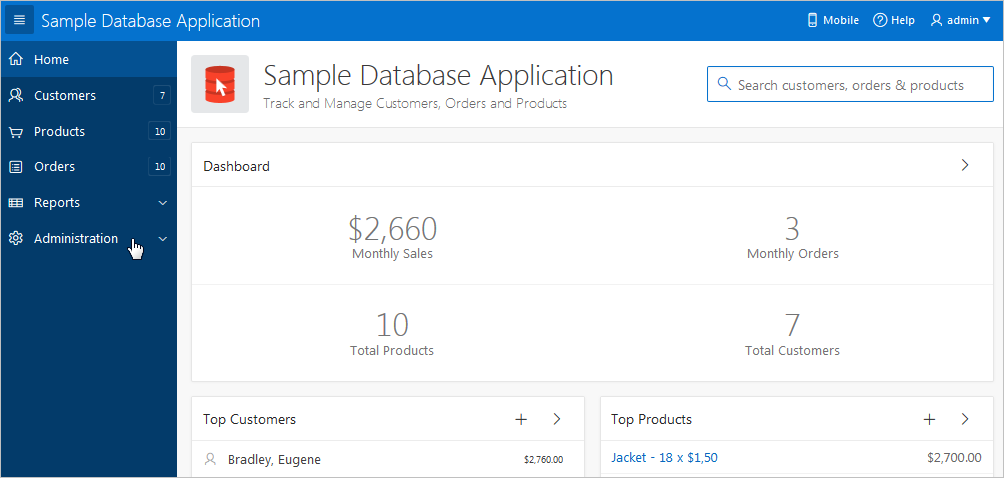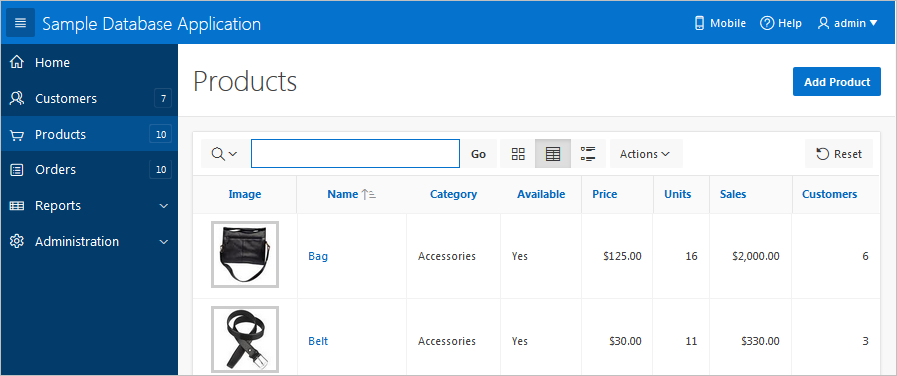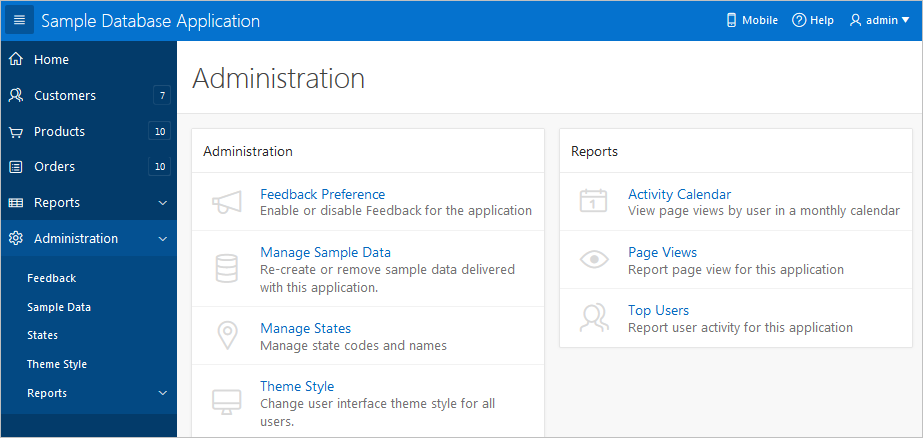3.3 Understanding Sample Database Application
Sample Database Application features an easy-to-use interface for viewing, updating, and searching order and customer information for clothing products. Users can navigate among the pages using the Home, Customers, Products, Orders, and Reports navigation menu. Like all sample packaged applications, Sample Database Application is fully editable.
Topics:
3.3.2 Understanding Sample Database Application
Sample Database Application demonstrates:
-
Examples of ways to display summary information.
-
Reports and forms for viewing, updating, and adding customers, products, and orders
-
Various charts and maps available in Oracle Application Express
-
Mobile pages to replicate the majority of functionality available in the desktop pages
Sample Database Application features the following built-in functionality and key pages:
Tip:
The size of left navigation menu changes depending upon the size of the window. In some of the images in this section, the navigation menu is minimized.
Topics:
- Home Page
- Customers Page
- Using the Customers Page
- Products Page
- Using the Products Page
- Orders Page
- Using the Orders Page
- Reports Page
- Administration Page
- Accessing the Mobile Version
See Also:
3.3.2.1 Home Page
The home page contains the following main regions:
-
Dashboard - Demonstrates the use of a Badge List plug-in. This regions displays a value based on an underlying SQL statement. Links in this region take you to reports on Monthly Sales, Monthly Orders, Total Products, and Total Customers.
-
Top Customers - Demonstrates the Slider Tooltip plug-in. This regions displays a value based on an underlying SQL statement. Links in this region take you to reports on Monthly Sales, Monthly Orders, Total Products, and Total Customers.
-
Top Products - Top Products is an interactive report. The report is based on an underlying SQL statement and displays a subset of the information that appears on the Customers page. Users can view the additional details by clicking the product or by clicking the view Products icon (a right arrow) in the upper right corner of the region.
-
Top Orders by Date - Demonstrates the use of a HTML5 Bar Chart plug-in. This chart displays orders by date and order amount, based on an underlying SQL statement. Users can view the Orders page by clicking the right arrow in the upper right corner.
-
Tags - Demonstrates the use of a Tag Cloud plug-in. This region displays a value based on an underlying SQL statement. Links in this region take you to search results matching the selected tag.
See Also:
3.3.2.2 Customers Page
The Customers page enables users to view and edit customer information.
Customers is an interactive grid tracking customer information. To search for a customer information, enter search terms in the Search field and click Go. To sort by customer, click the column heading and then select the sort icons.
You can change the appearance of the report using the Actions menu.
See Also:
3.3.2.3 Using the Customers Page
This section describes functionality built into the Customers page.
3.3.2.3.1 Editing a Customer
To update existing customer information:
- Click the customer name.
- On the Customer Details page, edit the fields and click Apply Changes.
- To delete a customer, click Delete.
3.3.2.3.2 Creating a Customer
To add a new customer:
- Click the Create Customer button.
- On the Customer Details page, edit the fields and click Add Customer.
3.3.2.3.3 Uploading Data
To upload data:
-
Click the Upload Data button.
-
For Import From:
-
Import From - Select either:
-
Upload file, comma separated (*.csv) or tab delimited. If selected, select the file in the File Name form element.
-
Copy and Paste. If selected, a Copy and Paste field displays at the bottom on the window.
-
-
Separator - Identify a column separator character. Use \t for tab separators.
-
Optionally Enclosed By - Enter a delimiter character. See field-level Help for more details.
-
First Row has Column Names - Select or deselect Yes.
-
File Character Set - Select the appropriate file character set.
-
Click Next.
-
-
On Data/Table Mapping, review the mappings and click Next.
-
Click Load Data.
-
Review Results.
-
Click Finish.
3.3.2.4 Products Page
The Products page enables users to view and edit product information. The Products region is based on a SQL query that uses a custom function for displaying images stored in the database.
By default, this page displays in Report view. You can change the view by clicking View Icons and View Detail to the left of the Actions menu. In Report view, you can sort by column by clicking the column heading and then selecting the icons. Users can change the appearance of the report using the Actions menu.
3.3.2.5 Using the Products Page
This section describes functionality built into the Customers page.
Topics:
3.3.2.5.1 Editing a Product
To update existing product:
- Click the product name.
- On the Product Details page, edit the fields and click Apply Changes.
- To delete a product, click Delete.
3.3.2.6 Orders Page
The Orders page enables users to create, view, and edit customer orders.
Orders is an interactive report for tracking order information. To sort by column, click the column heading and then select the appropriate sort icon. You can change the appearance of the report using the Actions menu.
See Also:
3.3.2.7 Using the Orders Page
This section describes functionality built into the Orders page.
Topics:
3.3.2.8 Reports Page
The Reports page enables you to view information in various formats, including bar chart, pie chart, map, tree, and tags. To view a report or chart, select it.
See Also:
3.3.2.9 Administration Page
Use the Administration page to manage sample data, manage state codes and names, and enable user feedback capability. Use the reports on the right side of the page to view user activity, view pages views, and view page views in a monthly calendar.
The Administration contains two regions: Administration and Reports.
The Administration region contains these sections:
-
Feedback Preference - Enable, disable, and manage feedback for the application.
-
Manage Sample Data - Remove or re-create the sample data that ships with Sample Database Application.
-
Manage States - Add, edit, or delete states.
-
Theme Styles - Change the user interface theme style for all users.
The Reports region contains these sections:
-
Activity Calendar - Displays page views by user in a monthly calendar.
-
Page Views - Displays a report of page views by user in the application.
-
Top Users - Displays a report of user activity for this application.
See Also:
3.3.2.10 Accessing the Mobile Version
Clicking Mobile in the upper right corner of the home page displays Sample Database Application in a format compatible with a mobile device. This mobile version replicates the majority of functionality available in the desktop version.
To access the mobile version of Sample Database Application:
See Also:
3.3.3 Modifying Sample Database Application
One approach to learning how to build applications in Oracle Application Express is to study Sample Database Application.
Topics:
3.3.3.1 Why Modify a Sample Database Application?
Once you understand the type of functionality available in a packaged application, such as the Sample Database Application, the next step is to learn more about the construction of each page. An efficient way to speed up the learning process is to analyze and deconstruct the pages in the packaged applications. If you happen to break something, you can quickly delete the packaged application and install it again.
Tip:
Oracle Application Express includes two types of packaged applications: sample and productivity applications. By default, sample applications are fully editable. In contrast, you must unlock a productivity application before you can edit it. Unlocking a productivity packaged application makes it ineligible for future upgrades or support by Oracle Support.
3.3.3.2 Editing Sample Database Application
Tip:
When you create a desktop application page, you choose a Page Mode: Normal or Modal. A Normal page is a standard Oracle Application Express page. A Modal dialog is an overlay window which remains active until the end user closes it. When you run an editable Normal page, the Runtime Developer toolbar displays at the bottom of the page. Use the Developer toolbar to quickly edit the current application or currently running Normal page, or view session state. You cannot edit a Modal dialog page from the Runtime Developer toolbar.
To edit a running application, click the Application link on the Runtime Developer toolbar. The Application home page appears. The application ID and application name display at the top of the page.
The pages that comprise the application appear on the bottom of the Application home page. To access a specific page, simply click it. To search for a specific page, enter a case insensitive query for the page title or page number in the Search field and click Go.
See Also:
"Using the Application Home Page" and "Runtime Developer Toolbar"







